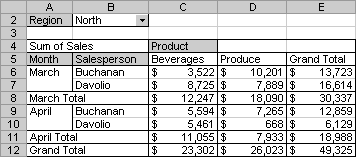Returns data stored in a PivotTable report. You can use GETPIVOTDATA to retrieve summary data from a PivotTable report, provided the summary data is visible in the report.
Note You can quickly enter a simple GETPIVOTDATA formula by typing = in the cell you want to return the value to and then clicking the cell in the PivotTable report that contains the data you want to return.
Syntax
GETPIVOTDATA(data_field,pivot_table,field1,item1,field2,item2,...)
Data_field is the name, enclosed in quotation marks, for the data field that contains the data you want to retrieve.
Pivot_table is a reference to any cell, range of cells, or named range of cells in a PivotTable report. This information is used to determine which PivotTable report contains the data you want to retrieve.
Field1, Item1, Field2, Item2 are one to 14 pairs of field names and item names that describe the data you want to retrieve. The pairs can be in any order. Field names and names for items other than dates and numbers are enclosed in quotation marks. For OLAP PivotTable reports, items can contain the source name of the dimension as well as the source name of the item. A field and item pair for an OLAP PivotTable might look like this:
"[Product]","[Product].[All Products].[Foods].[Baked Goods]"
Remarks
- Calculated fields or items and custom calculations are included in GETPIVOTDATA calculations.
- If pivot_table is a range that includes two or more PivotTable reports, data will be retrieved from whichever report was created most recently in the range.
- If the field and item arguments describe a single cell, the value of that cell is returned regardless of whether it is a string, number, error, and so on.
- If an item contains a date, the value must be expressed as a serial number or populated by using the DATE function so that the value will be retained if the spreadsheet is opened in a different locale. For example, an item referring to the date March 5, 1999 could be entered as 36224 or DATE(1999,3,5). Times can be entered as decimal values or by using the TIME function.
- If pivot_table is not a range in which a PivotTable report is found, GETPIVOTDATA returns #REF!.
- If the arguments do not describe a visible field, or if they include a page field that is not displayed, GETPIVOTDATA returns #REF!.
Examples
The range that contains the PivotTable report is:

GETPIVOTDATA("Sales",$A$4) returns the grand total of the Sales field, $49,325.
GETPIVOTDATA("Sum of Sales",$A$4) also returns the grand total of the Sales field, $49,325; the field name can be entered exactly as it looks on the sheet, or as its root (without "Sum of," "Count of," and so forth).
GETPIVOTDATA("Sales",$A$4,"Month","March") returns the grand total for March, $30,337.
GETPIVOTDATA("Sales",$A$4,"Month","March","Product","Produce","Salesperson","Buchanan") returns $10,201.
GETPIVOTDATA("Sales",$A$4,"Region","South") returns #REF! because the South region data is not visible.
GETPIVOTDATA("Sales",$A$4,"Product","Beverages","Salesperson","Davolio") returns #REF! because there is no total value of beverage sales for Davolio.